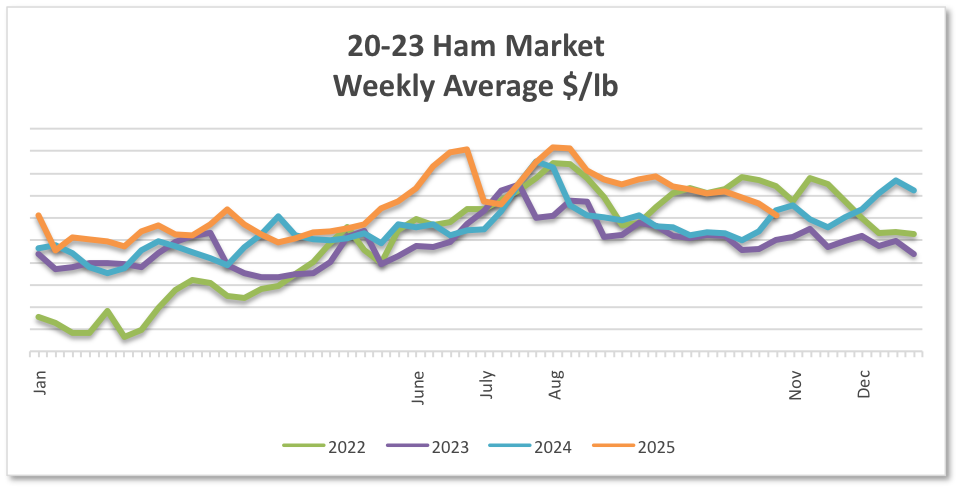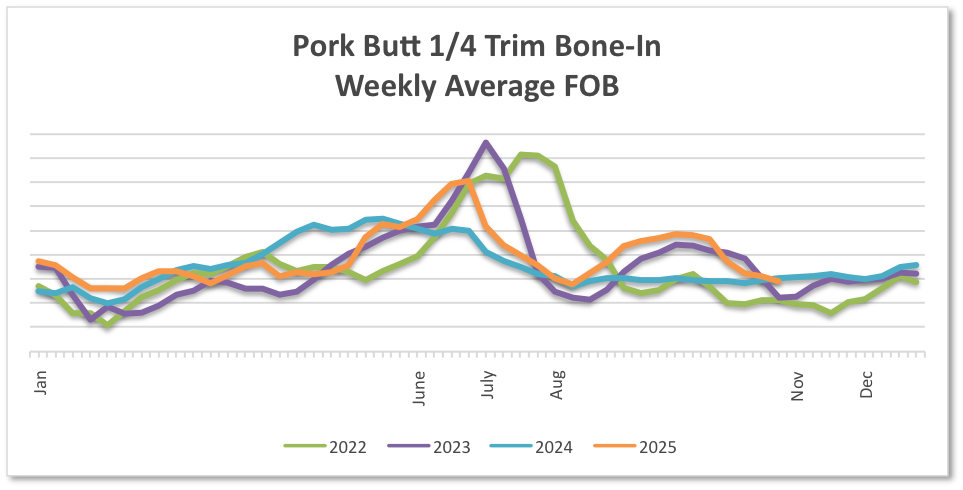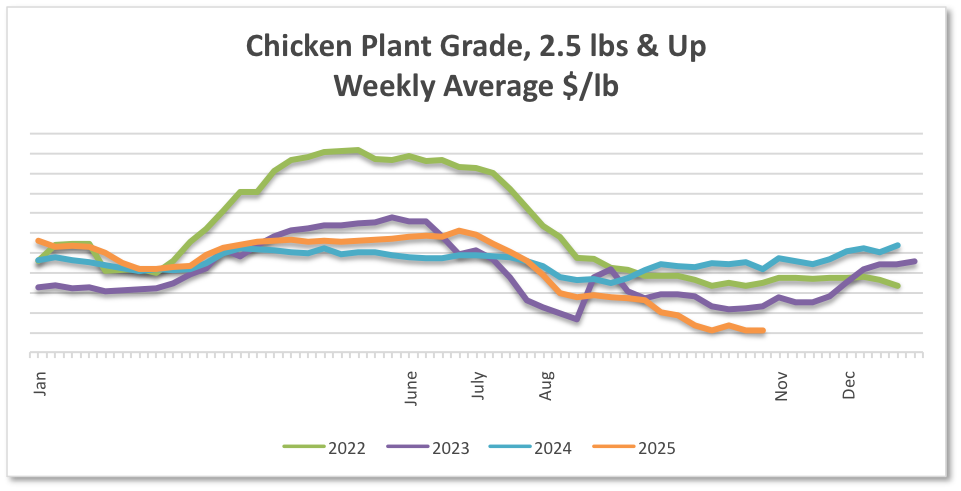Week Ending December 12, 2025
BEEF
The market is steady to weaker. Total beef production for last week was up 20.7% versus the prior week and up 0.4% compared to the same week last year. Year to date, total production is down 4.3% compared to the same period last year. The total headcount for last week was 600,000 compared to 614,000 for the same week last year. Year to date, the total headcount is 27.31 million head, which is down 7.0% from last year. Live weights for last week were up 2 lbs. versus the prior week and are up 26 lbs. from the same week last year. Price offerings are more elevated compared to last year, but the overall cutout trend has been moving lower on a weekly basis. While the beef cutout has been moving lower, it still remains about 20% higher year over year. Live futures were mixed with December showing slight weakness while February and April were showing some upside movement. Cattle slaughter statistics have been reported the past two weeks, which helps buyers and sellers better analyze market conditions. Higher prices on boxed beef continue to test the resilience of trade values and retailers’ willingness to promote beef in weekly features. Boxed beef prices on middle meats and end cuts trended lower over the last week in combination with the seasonal slowdown. Holiday bookings on ribeyes and PSMO’s will be of utmost importance due to tight supply this year. The spread between choice and select grades remains fairly tight.
Grinds – The market is steady to weaker. Demand has been sluggish at the beginning of December with fewer retail features. Overall pricing is up about 33% YOY which is keeping a lid on feature activity. On the supply side, Mexican imports have been halted due to issues with the New World Screwworm. Trade levels on 73% and 81% had downward pressure over the last week.
Loins – The market is steady to weaker. Demand is moderate but the seasonal slowdown is starting to be noticed. Higher retail prices and limited feature activity are having an effect on consumer purchases. Inventories vary by supplier and packing plant. Market levels on choice product have been pressured lower.
Rounds – The market is steady to weaker. Weekly demand is moderate but has been slowly drifting lower since mid-November. Demand from grinding operations has fallen over the last month. Availability varies by packer and sourcing plant. The market has been moving lower since late September.
Chucks – The market is steady to weaker. Demand is moderate for this time of year, but higher retail prices are stalling the category somewhat. With sellers moving out lingering inventory and retailers restarting feature activity, the category is firming up. Supply varies by packer and sourcing facility. Trade levels on chucks and clods have been declining but are showing signs of stabilizing.
Ribs – The market is steady to weaker. Demand is moderate and starting to get some momentum due to the upcoming holidays. Supply varies by packer and plant. Market levels, which were at historically high levels are starting to recede a bit.
PORK
The market is steady. Total pork production for last week was up 29.7% versus the prior week and up 4.0% compared to the same week last year. The total headcount for last week was 2,702,000, compared to 2,604,000 for the same week last year. Live weights for last week were even at 0 lbs. compared to the prior week and even at 0 lbs. versus the same week last year. Lean hog futures were mixed with December contracts moving lower and February showing some upward strength. Demand for fresh pork has slowed down since Labor Day, which is consistent with past annual trends. Cutout values and primal levels have been soft in recent months but are starting to firm up as retailers plan for New Year’s features. YOY slaughter is down about 1.7% which has tightened supply just a bit. Grocery demand is meeting industry expectations as the retail community continues to use pork as a key feature component. In the fresh meat complex, volume on loins, butts, hams, and ribs is starting to show week-to-week stability. Tariffs have industry participants concerned but limited information is being reported about any actual effects. At the current time, approximately 25% of U.S. production goes to the export channel. Market values in most categories have steady overtones as the industry moves to close out the year.
Bellies – The market is steady to weaker. Demand from the retail and foodservice channels continues to be reported as sluggish. After raw bellies peaked in July, the market has had a soft bias since mid-September. Supply is available. The market is soft but is showing signs of stabilizing.
Hams – The market is steady. Demand for bone-in and boneless hams remains a full-steady with two major holidays at the end of the month. Export business to Mexico on bone-in hams is fair. Supply is tight. Market levels are firm with limited spot availability.
Loins – The market is steady. Retail demand for bone-in and boneless loins is moderate to good and retail feature activity is giving additional support. Export demand for boneless strap-on product is good. Supply varies by packer. The market is mostly moving sideways.
Butts – The market is steady. Retail business is moderate and is starting to show signs of strength as we get closer to year end shipments. Export demand to Mexico and the Pacific Rim is status quo. Supply is available. Trade levels have firmed up recently.
Ribs – The market is steady. Retail and foodservice demand is moderate during the non-seasonal time of year. Buyers are looking for spot deals for freezer inventory. Supply varies by packer and plant. The market on spareribs, St. Louis Ribs, and back ribs is mostly flat.
CHICKEN
The market is steady. The total headcount for the week ending 12/6/2025 was 173,347,000 as compared to 168,214,000 for the same week last year. The average weight for last week was 6.64 lbs. as compared to 6.53 lbs. for the same week last year. Volume from the retail and foodservice channels is vibrant and some processors are pulling back on production to keep supply and demand in balance over the next few weeks. WOGS and breast meat are reported to be a full-steady. Demand for the remaining categories of tenderloins, wings, and dark meat is moderate to good. Export demand for leg quarters and whole legs is status quo and meeting industry trends. Improved slaughter numbers YOY continue to add more finished pounds to the marketplace. Market levels are mostly flat as supply and demand patterns appear to be on equal footing.
WOGS – The market is steady. Demand from retail deli and fast-food QRS’s is vibrant enough to keep the premium sizes sold up. Supply is limited on smaller WOGS. Market levels have flattened out.
Tenders – The market is steady. Demand from the foodservice and QSR channels has shown improvement in early December. Custom portioning is in balance with supply. Supply is available but not in excess. The market on select and jumbo sizes is mostly flat.
Boneless Breast – The market is steady. Demand for retail case-ready and jumbo CVP product is moderate to good. Suppliers are trying to take a more aggressive stance while buyers are trying to hold off purchases. Supply is available but not in excess. The market is holding even.
Leg Quarters and Thighs – The market is steady. Retail demand for drums and thighs is moderate at best. Export business on whole legs is status quo. Supply is available. The market on drums and thigh meat is mostly unchanged.
Wings – The market is steady. Demand from foodservice and further processors is in balance with supply. Supply is available on most sizes. The market is moving sideways.
TURKEYThe market is steady. The total headcount for the week ending 12/6/2025 was 3,780,000, as compared to 3,275,000 for the same week last year. The average weight for last week was 30.95 lbs. as compared to 33.24 lbs. for the same week last year. Retail and foodservice demand is moderate as the industry approaches the holiday season. With limited supply and static demand, very little information on spot trading is being reported. Whole birds, back-half parts, and boneless breasts continue to be sought after. The overall supply side has been constrained in calendar 2025. With the respiratory virus reported earlier this year, bird weights were reduced which had a negative impact on production pounds. Less production has also resulted in lower cold storage inventory. Asking prices are holding within established ranges due to the lack of supply on boneless breast, drums, and wings. Market levels across most categories are a full-steady.
Whole Birds – The market is steady. Very few spot transactions are being reported. Due to tight supply and bird weight issues, a lot of spot trading is on aged product. Market levels on spot loads are mostly firm.
Breast Meat – The market is unsettled. Domestic demand from the retail, foodservice, and QSR channels is moderately consistent. Fresh and frozen supply is tight with limited offerings. Market levels are moving sideways with limited spot sales.
Wings – The market is steady to firmer. Export business on whole wings is fair. Domestic volume on two-joint wings is strong with less than adequate supply. Supply for cut wings is tight. The market has been pressured higher on Tom and Hen sizes.
Drums and Thigh Meat – The market is steady. Export demand for drums is status quo for this time of year. Domestic demand for ground turkey continues to be strong. Supply is barely adequate on parts and thigh meat. The market is moving sideways on the back half of the bird.
SEAFOOD
White Shrimp – The market is firmer. Supplies are barely adequate to adequate while maintaining a firm undertone.
Black Tiger Shrimp – The market is firmer. Supplies are barely adequate to adequate while maintaining a firm undertone.
Gulf Shrimp – The market is firmer. Supplies are barely adequate to adequate while maintaining a firm undertone.
North American Lobster Tails – The market is steady to weaker. The warm-water tail market continues to face broad discounts as sellers respond to weak demand and increased competition. Pricing remains under pressure as participants work to encourage movement in an otherwise subdued marketplace.
Salmon – The market is unsettled. Farmed salmon is unsettled with pricing influenced by sellers’ supply positions. There are reports of offers above and below the current range. The West Coast whole fish market is barely steady. Supplies are barely adequate and unquoted in some instances. Europe is reporting a firmer market. The Norwegian and Scottish whole fish markets are firmer. Increased prices and higher demand are being reported. The Chilean whole fish market is steady to firmer. Supplies are fully adequate with moderate demand.
Cod – The market is firmer. There is a steady to firm undertone in the market. Demand is moderate, while supplies have tightened.
Flounder – The market is steady and mostly unchanged.
Haddock – The market is firmer. There is a steady to firm undertone in the market. Demand is moderate, while supplies have tightened.
Pollock – The market is firmer. Supplies are adequate with moderate demand.
Tilapia – The market is unsettled. There are reports of slow demand, which has the potential to create long inventory positions.
Swai – The market is steady to firmer.
DAIRY
CHEESE
The market is weaker. Both the CME Block and Barrel markets moved weaker as the week progressed. Both markets trended weaker than the prior week. In the East, cheese production is steady to light. Some contacts note a decline in bulk production as fulfillment of holiday orders is coming to completion. In the Central region, bulk cheese production is increasing while others are focused on curds and retail products. Spot loads in the region are readily available. In the West, strong milk production is providing milk volumes to cheese manufacturers. Class II and IV dairy commodity manufacturing in the region is placing increased demand on spot milk loads in some cases. Cheese production schedules in the region vary from steady to stronger. Retail production is the highest priority for cheesemakers due to strong demand from consumers. Some stakeholders note the holidays are not bringing in the usual upticks in demand on the domestic foodservice side. Inventory levels are reported to be balanced. Domestic demand is steady. Export demand for cheese varies from steady to strong.
In Europe, milk production is reported to be mixed. Year-over-year milk production is generally up for European countries. Cheese production schedules in Europe vary from steady to stronger. Stakeholder sentiment varies from stable to somewhat bearish. Retail and foodservice demands for foreign type cheese are reported to be stronger. Export demand is strengthening with European produced loads becoming more competitive in the international buyer space.
BUTTER
The market is firmer. The butter market moved firmer as the week progressed and trended firmer than the prior week. As cream is widely available across the nation, butter makers are keeping churns active. In the Northeast, many facilities are operating churns seven days a week. Some facilities report purchasing spot loads of cream to keep up with demand. In the Central region, milk component levels are reported to be higher this year than in previous years. Butter makers in the region are seeing large volumes of cream available on the spot market. In the West, stakeholders note strong milk production and components are ensuring spot cream loads are widely available. Demand for cream from butter makers in the region varies from steady to stronger. Many butter producers are focusing on bulk butter production to accommodate international buyer needs and domestic bulk butter demand. Retail demand for butter is strong while foodservice butter demand is steady. Butter inventories are reported to be balanced. Exports of 82% butterfat butter continue to be strong. According to the USDA, stakeholders note 2025 export demand is easily exceeding forecasts.
EGGS
The market is fair to weaker. Retail demand is viewed as only fair, with more suppliers reporting softer-than-expected orders. The early seasonal uptick tied to Christmas buying has not developed, and some suggest retailers may have overbought ahead of Thanksgiving. Even two weeks after the holiday, meaningful replenishment has yet to occur, keeping overall movement subdued. Distribution channel activity remains slow, with buyers delaying restocking as they wait for potential further price declines before taking on additional inventory. Canadian demand is also subdued, providing little support to the broader market.
Market levels have moved higher on medium sizes and large sizes. National weekly reports show shell egg inventory up 3.7% and breaking stock inventory up 0.7% over last week.
Demand in the egg products category is steady to weaker. Liquid whites and yolks are being sourced within quoted levels on the open market. Dried products are weaker with the bulk of year-end coverage already secured.
FLUID MILK
The market is strong. Milk production across the country is steady to stronger. In the East, milk availability is reported to be tightening. According to the USDA, despite strong output at the farm level, demand for milk is strengthening. Bottling demand is strong and anticipated to be strong for the foreseeable future. In the Southeast, bottlers are reported to be bringing in milk from other regions to supplement supplies. In the Central region, milk outputs are seasonally higher. Milk components are strong compared to last year. In California, milk production is steady to strong. In the Pacific Northwest, farm level outputs are mixed though volumes are meeting processing needs in the area. According to the latest milk production report from the National Agricultural Statistical Service (NASS), milk cows in Washington state decreased 21,000 head and milk cows in Idaho increased 49,000 head in October 2025. In the Western region, year over year milk production is up. Stakeholders in the region note plant expansions coming online in 2026 are ahead of or on schedule.
Class I bottling demand is strong across the nation. Class II demand is strong. Spot loads of cream and milk are being sent to manufacturers who are focusing their operations on seasonal dairy products and dairy based baking ingredients. Class III demand is steady. Some cheesemakers report bringing in spot loads of milk for production needs. Class IV demand is steady to strong. Butter production has increased in response to the large volumes of cream available on the market as well as the increased retail demand for butter.
OIL
Soy Oil – The market is mixed. Soybean oil markets began in December with mixed sentiment following a holiday-shortened week. Futures saw modest gains early in the week, supported by firm crush activity and steady biofuel demand, though overall trade remained cautious amid corrective selling pressure across the soy complex. Export shipments were subdued, with USDA reporting volumes significantly below last year, reflecting ongoing logistical challenges and limited Chinese buying. Meanwhile, Brazilian planting progress reached 89%, slightly behind last year, raising mild supply concerns. Domestic fundamentals remain strong, with processors maintaining high crush rates, but global competition and macroeconomic uncertainty continue to temper bullish momentum.
Canola Oil – The market is mixed. Canola oil markets held a steady tone during early December, supported by strong domestic crush activity and firm renewable fuel demand. Canadian processors continued operating at high capacity, while export flows faced seasonal slowdowns due to logistical constraints and weaker Asian buying interest. Global oilseed markets remained volatile, with soybean and palm oil fluctuations influencing comparative spreads and substitution trends. Weather conditions across the Canadian Prairies were favorable, reducing immediate supply risks, though analysts flagged potential La Niña impacts for the next planting cycle. Overall, canola oil fundamentals remain solid, balancing strong industrial demand against trade uncertainties.
Palm Oil – The market is mixed. Palm oil markets started December with a cautious tone as export demand softened and inventories remained elevated. Malaysian shipments slowed compared to November, reflecting weaker buying from India and China amid competitive pricing from soybean oil. Production levels held firm, supported by favorable weather, but seasonal output peaks are expected to ease later in the month. Indonesia’s biodiesel mandate continued to absorb domestic supply, providing underlying support despite global trade headwinds. Sustainability compliance and currency fluctuations added complexity to export competitiveness. Overall, palm oil fundamentals balanced strong policy-driven demand against short-term export and inventory pressures.
COCOA
The cocoa market is unsettled. Supply issues for cocoa have been exacerbated by long lasting structural problems within the industry. Price increases on cocoa and any products produced with cocoa should be expected throughout the year.
COCONUT
The coconut market is mixed. Desiccated coconut costs are expected to settle in the coming months as global export prices from countries of origin have started to soften. That said, tariffs continue to impact the cost of imported goods. Coconut oil prices are mixed though reports indicate some softening over the last 30 days.
COFFEE
The coffee market is mixed. Concerns about tighter US coffee supplies due to tariffs are bullish for prices. Approximately a third of the United States unroasted coffee comes from Brazil.
IMPORTED PINEAPPLE
Thailand – Formerly the leading exporter for Pineapple products, Thailand’s production has collapsed recently due to severe drought and El Niño-driven heatwaves. Output for 2025 is below historical averages. Full recovery is unlikely before 2026.
Philippines – The market is noted as stable and resilient, with 2025 output estimated at 3.1 million tons. Major exporters maintain strong shipments to the U.S., Japan, and China, but internal demand and weather risks limit spot availability. Export volumes to China, Japan, and the U.S. are robust, but local weather risks and strong internal demand can limit additional availability.
Indonesia – Acting as a global buffer-supplier thanks to vertically integrated plantations, Indonesia’s supply is steady but peak-season volumes are limited, and competition for fruit is intense.
SUGAR
Domestic Cane Sugar – The market is mixed. U.S. sugar supply for 2025/26 is projected at 14.119 million short tons, raw value (STRV), a small decrease of 1,802 from last month as a reduction in imports narrowly offsets increases in beginning stocks and production. Cane sugar in Louisiana is projected at 2.162 million STRV (up 105,771 over November) and Florida is at 2.082 million STRV (up 29,879).
Domestic Beet Sugar – Beet sugar is projected at 5.098 million STRV, assuming sucrose recovery. August to September 2026 production is projected at 10-year averages and beet pile shrinkage at 8.660 percent. The shrinkage projection is from processors’ reporting forecasts in December and is higher than the 6.727% assumed in November. Overall beet production ends up decreasing 113,256 STRV from November. Imports have decreased 24,639 STRV to 2.289 million.
Mexico sugar production is projected at 5.094 million metric tons (MT), an increase over last month but still trending below earlier optimistic recovery prospects of some months ago. Rain and flooding in the states of Puebla, Veracruz, and San Luis Potosi have diminished sugarcane yield prospects.
RICE
The outlook for 2025/26 U.S. rice for December is for reduced supplies, unchanged domestic use, lower exports, and higher ending stocks. All rice supplies decreased on lower imports, down 1.0 million cwt to 49.7 million all on a reduction in long-grain imports. Long-grain exports are reduced 2.0 million cwt to 62.0 million on continued sluggish sales and shipments of rough rice to Mexico and other Latin American markets.
The 2025/26 global outlook this month is for increased supplies, lower consumption, higher trade, and larger ending stocks. Supplies are raised by 1.7 million tons to 730.7 million, as higher beginning stocks more than offset lower production. Beginning stocks are increased primarily for India, based on higher-than-expected beginning stocks reported by the Food Corporation of India. World production is forecast at 540.4 million tons, down 0.5 million this month.
WHEAT
The wheat market is steady. According to the December World Agricultural Supply and Demand Estimates (WASDE), the outlook for 2025 U.S. wheat is for larger supplies and higher ending stocks, with no change to use. The global wheat outlook is for higher supplies, consumption, trade and ending stocks. Supplies are projected to increase based on higher production from most major wheat exporting countries such as Argentina, Australia, Russia, Canada, the European Union and the United States. World trade is increased primarily on greater exports for Argentina, Australia, and Kazakhstan.
**Graphs represent data for the week ending December 5, 2025**


























